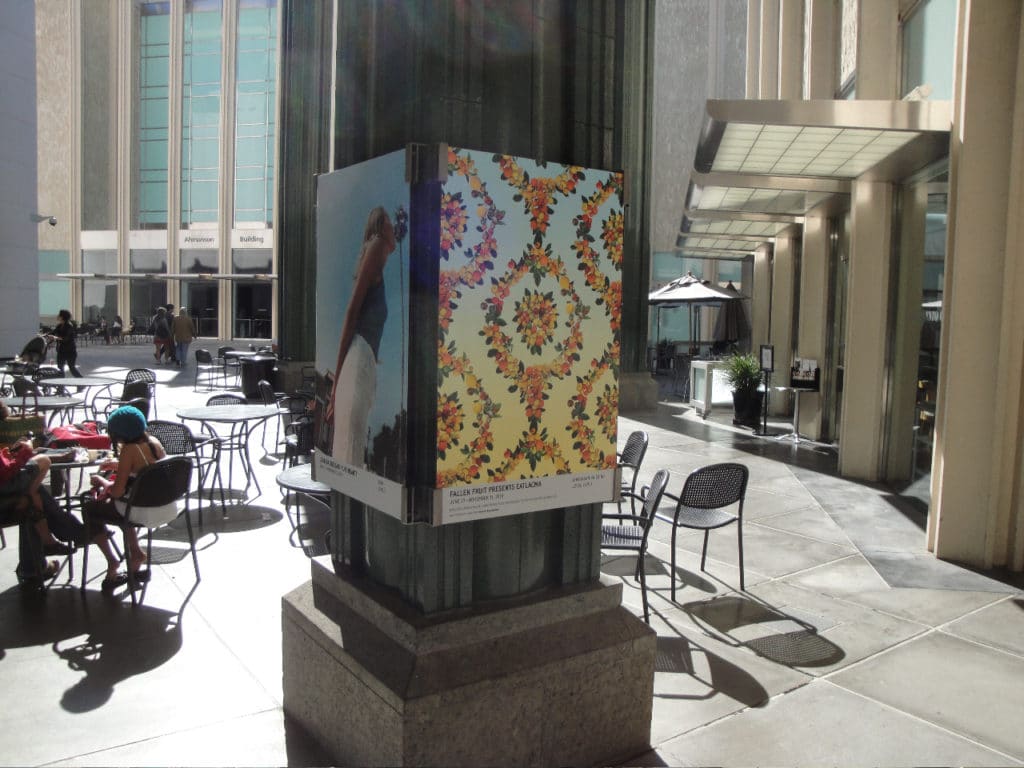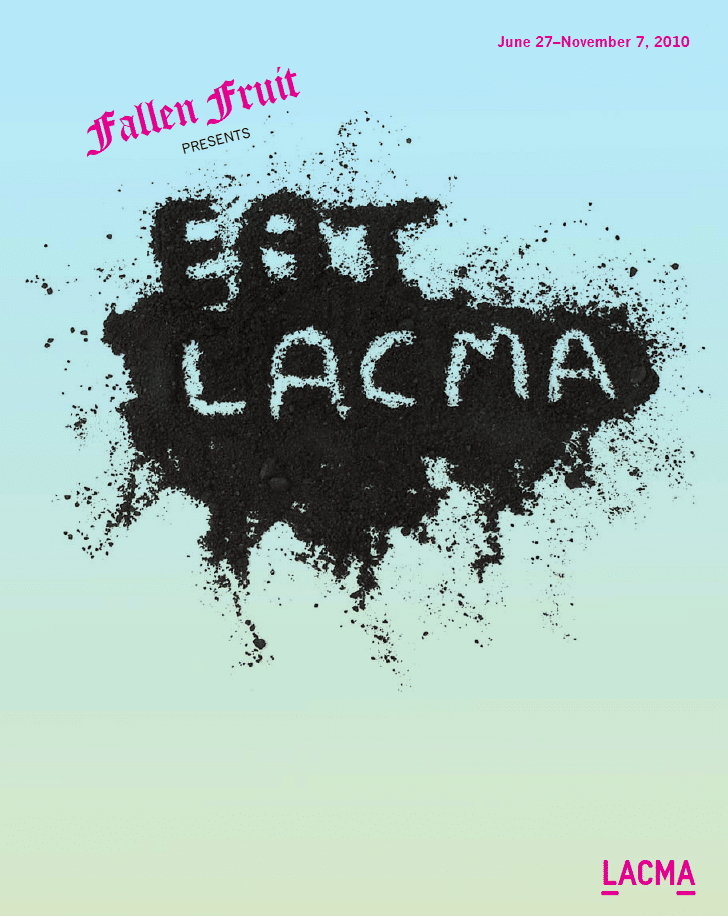Projects
Public Fruit Wallpaper, S.L.C.
Public Fruit Wallpaper Salt Lake City, dimensions variable, 2011
Created for the Utah Museum of Contemporary Art, this wallpaper depicts apple blossoms and budding apples against a Utah-sky blue backdrop. Everything in the image was collected over two days in Salt Lake City and the apple was chosen because of its place in the history of North American westward colonization.
Public Fruit Wallpaper L.A.
Public Fruit Wallpaper Los Angeles, dimensions variable, 2010
A wallpaper consisting of all the public fruit found in our neighborhood of Silver Lake in Los Angeles on a single day in March, arranged in a traditional lattice-and-medallion pattern against a gradient sky. Because of the season, all of it is citrus, and it includes fallen fruit found in the gutter, some of it split, rotting, or with insects. Commission for the Los Angeles County Museum of Art.
Public Fruit Theater
Public Fruit Theater, Los Angeles County Museum of Art, 2010-11
Rather than looking at fruit trees as simply a source of food, Public Fruit Theater examines the tree as a durational performance. Viewers complete the story through observation, witnessing the tree’s leafing out, blooming, and ripening of its fruit. The space is open to both performance and contemplation, observing the public or the fruit. The broken concrete of the installation indexes the margins of the city, the sidewalks that both connect us and separate us. Created in collaboration with La Loma Development.
Public Picnic Tables
Public Picnic Tables York, Alabama, installation, 2012
A set of ten picnic tables at the Coleman Arts Center engraved with quotations from the community of York, Alabama. Gathered at Gobble Gobble Cobbler, a fruit cobbler and public conversation event by Fallen Fruit, the quotes reflect the residents’ feelings about fruit, history and public space. The tables were crafted by a York carpenter, Dennis Sturdivant, of local materials.

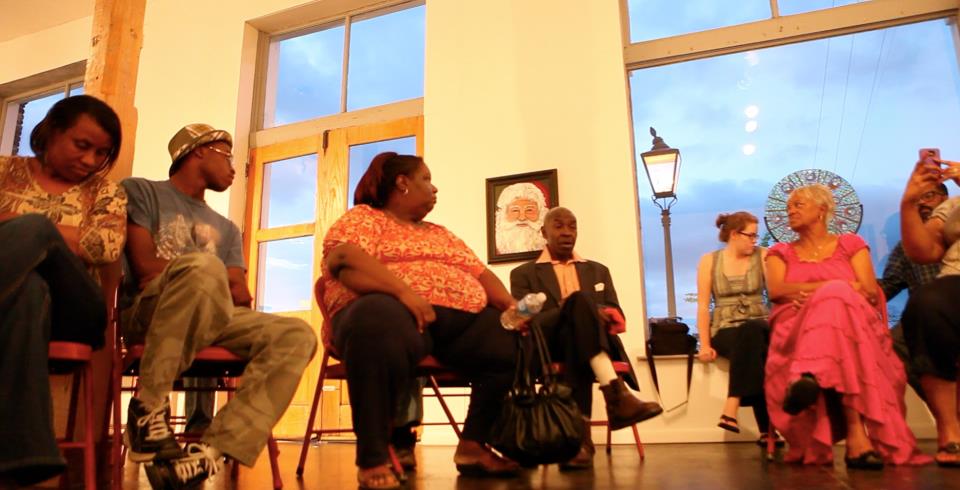
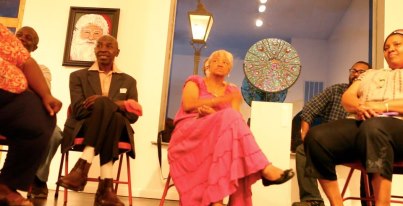
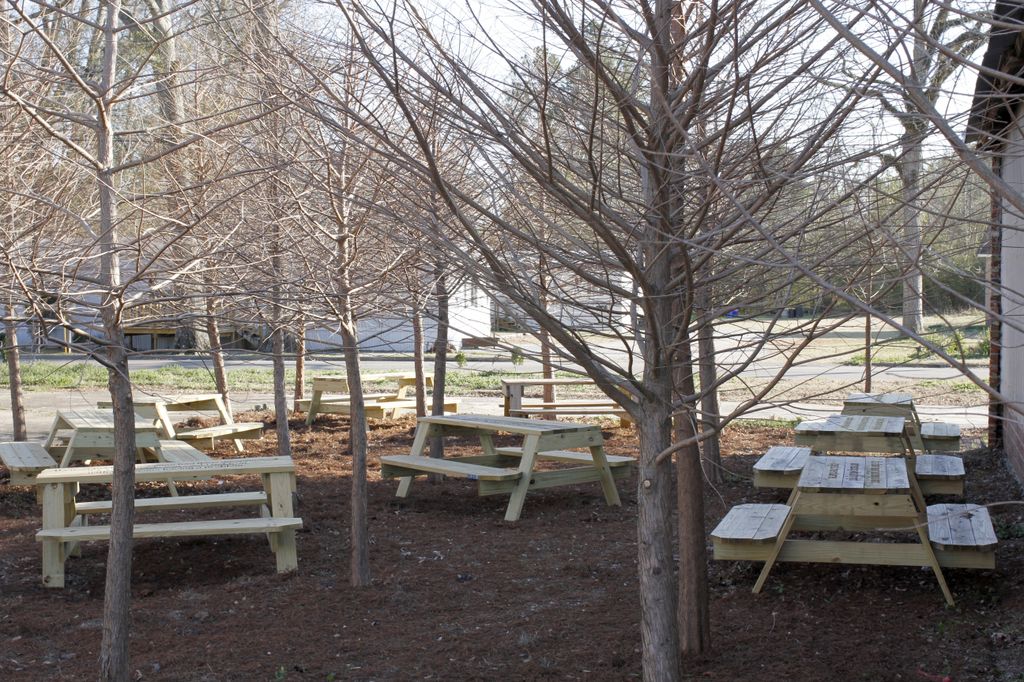
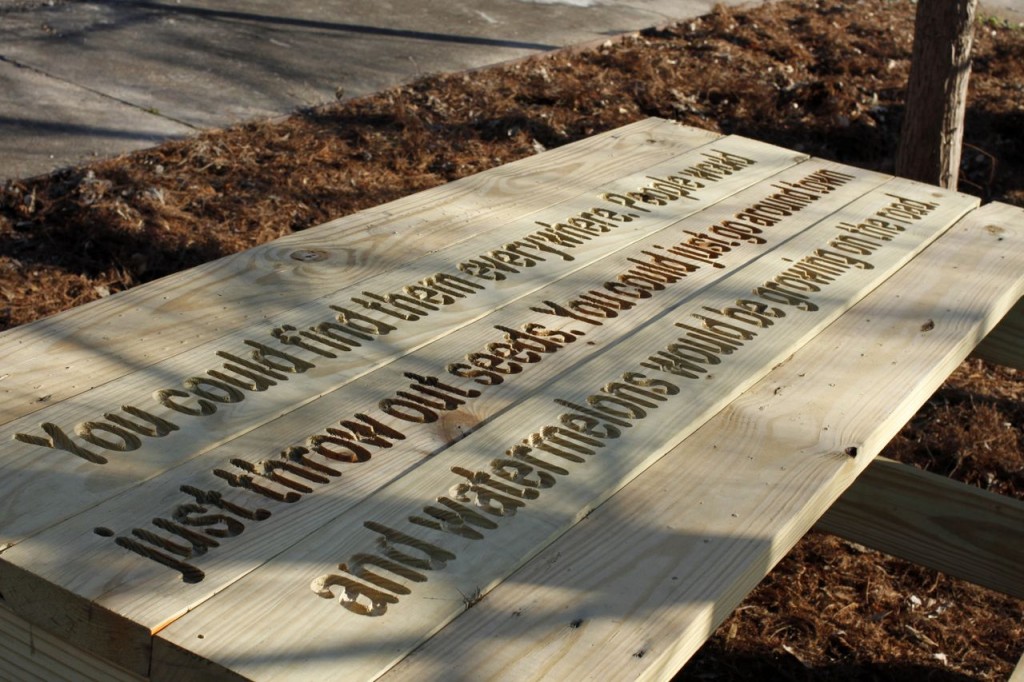
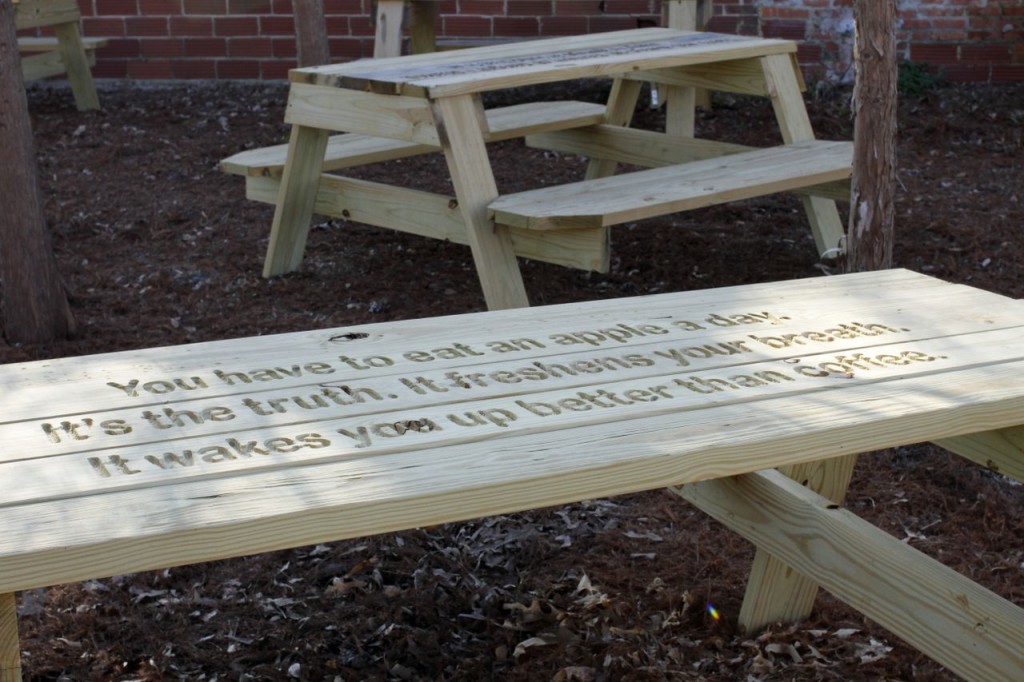
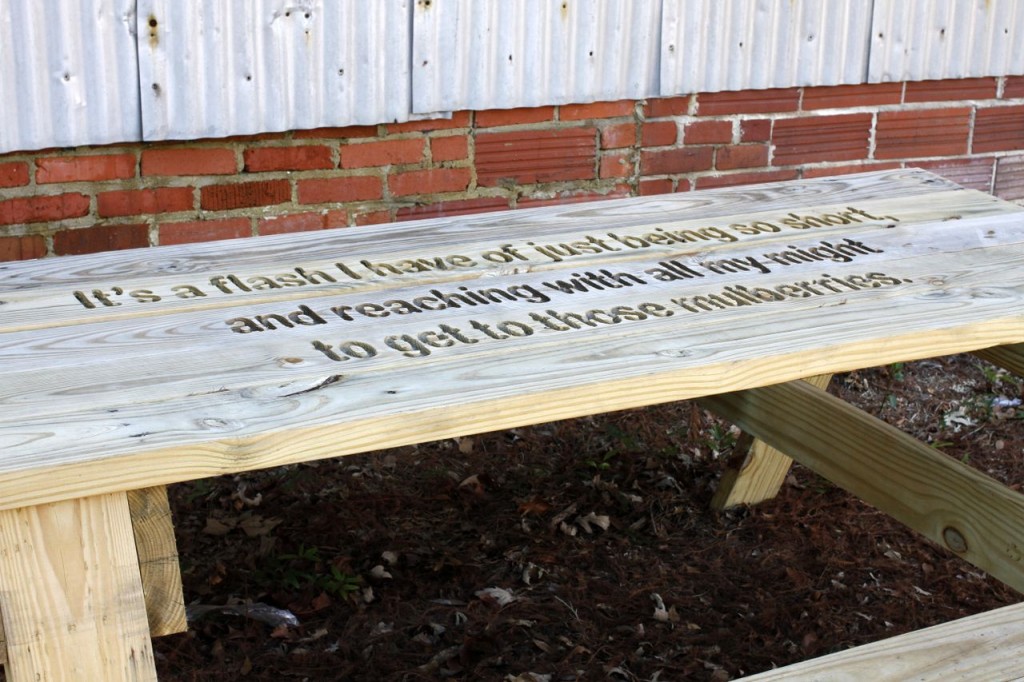


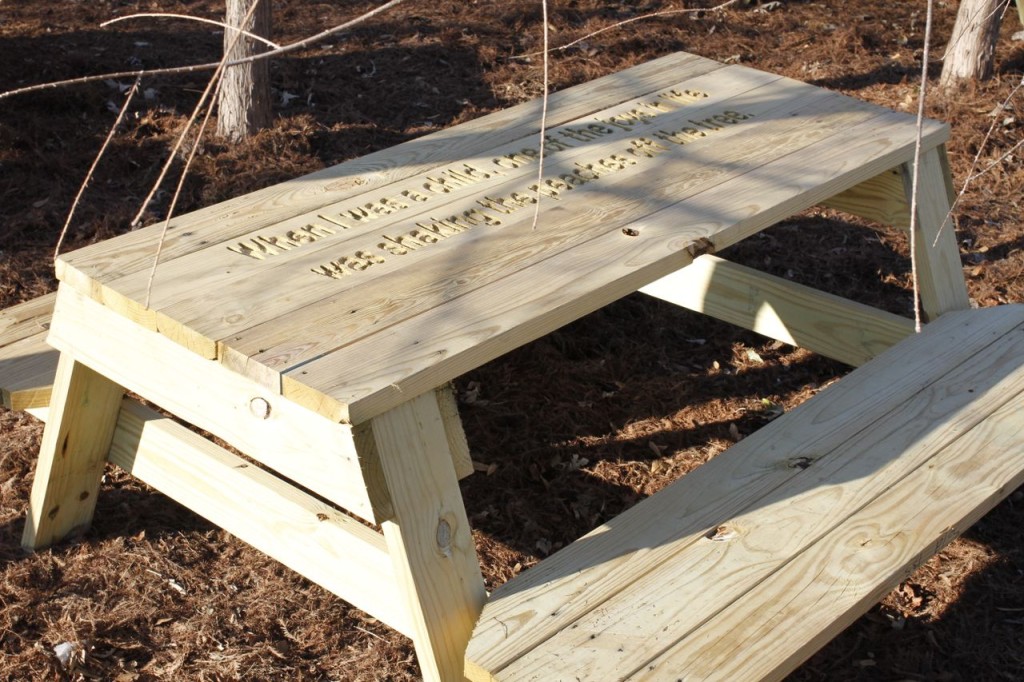
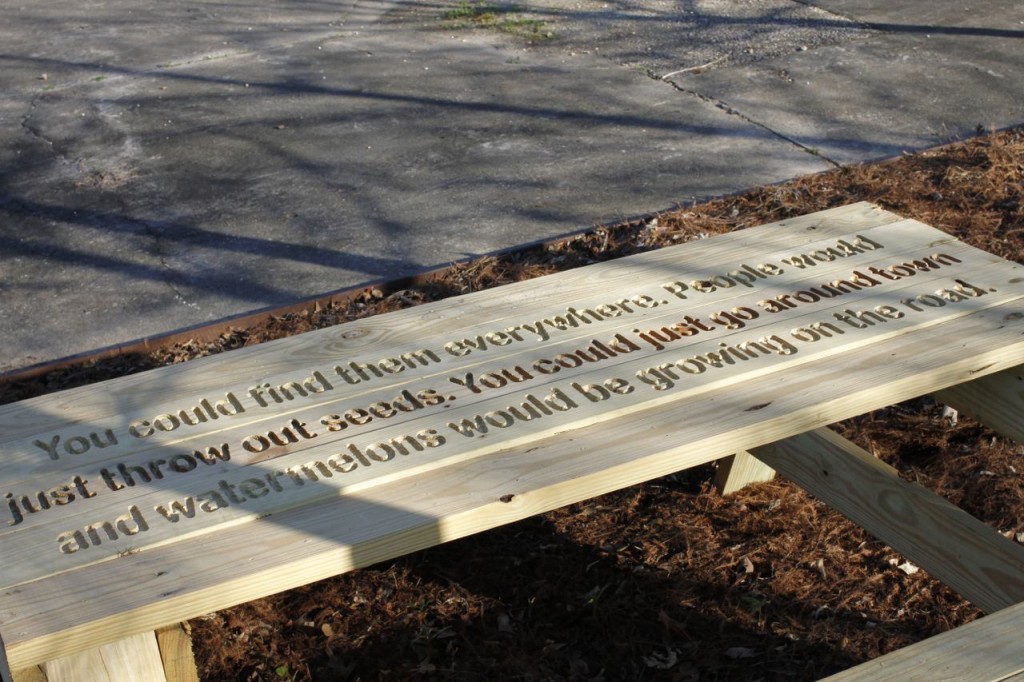
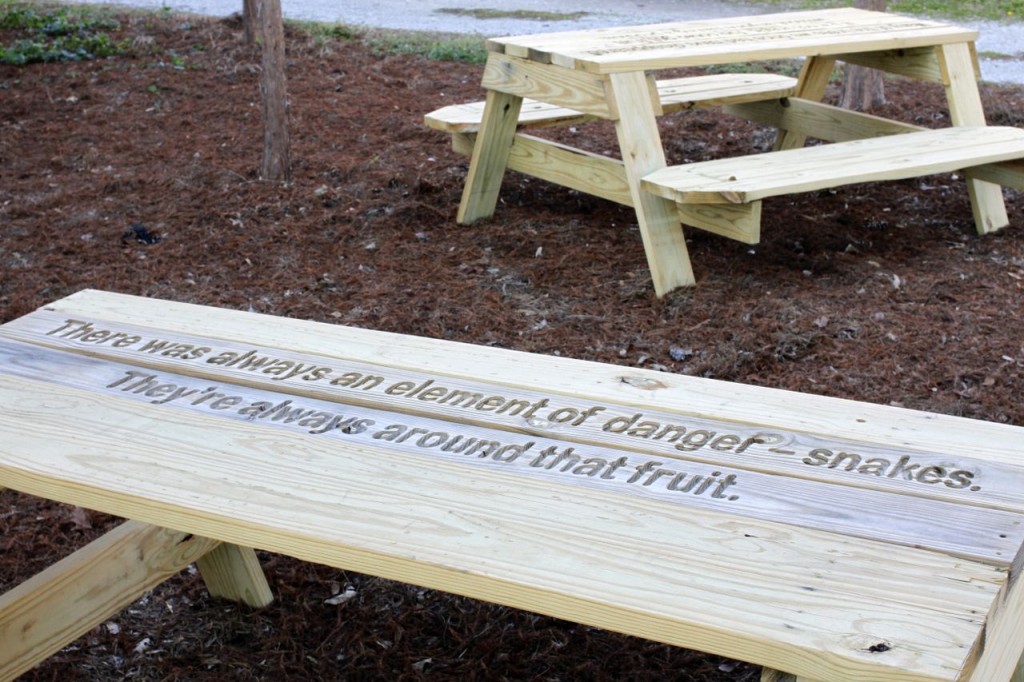
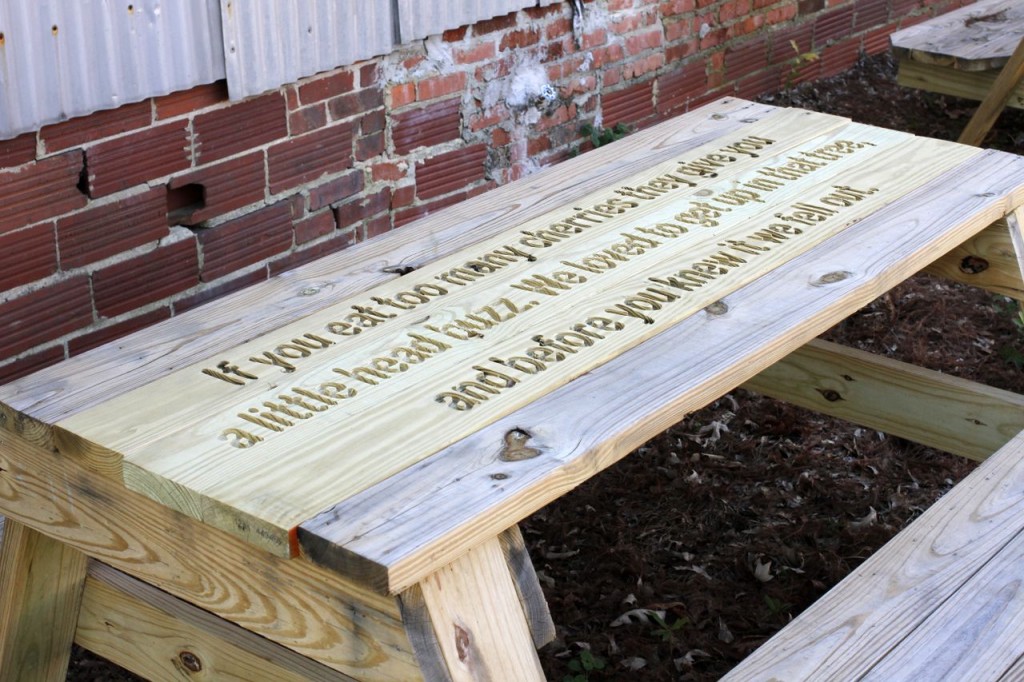
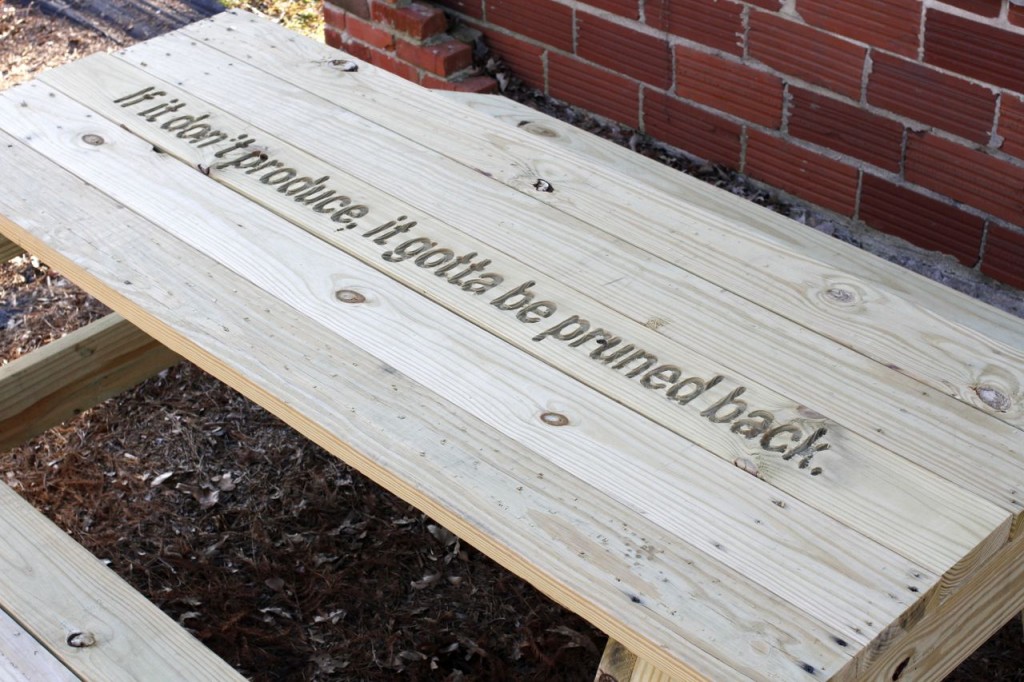
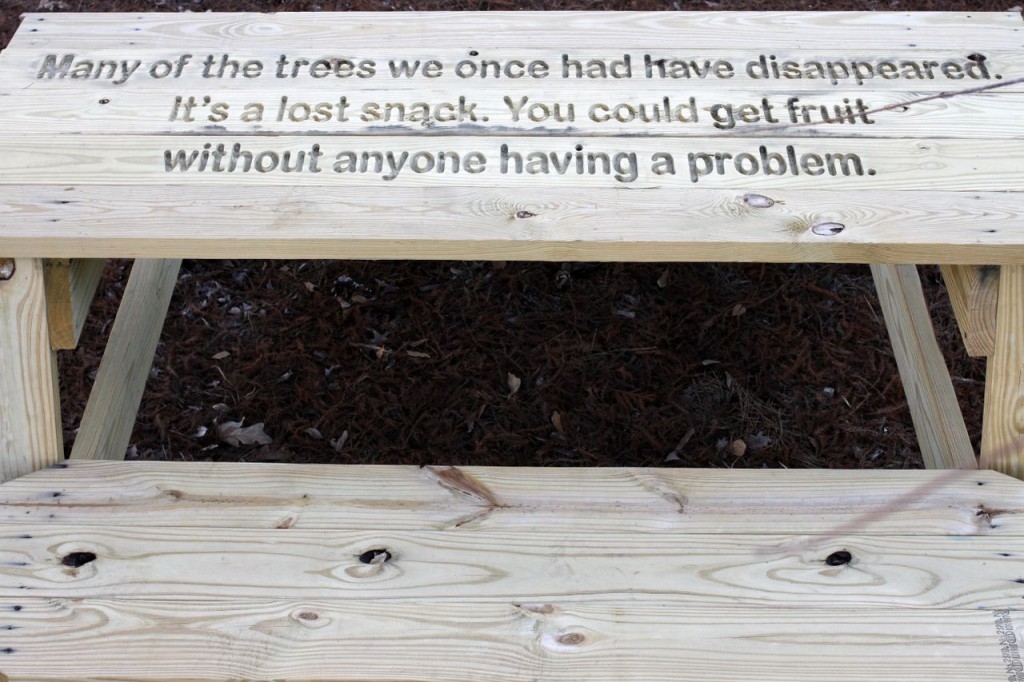

Public Fruit Meditation
Public Fruit Meditation, public participatory performance, 2011 – ongoing
An array of meditations and visualizations designed for small groups in intimate settings. Each sequence imagines fruit differently to raise consciousness about symbolic values, politics, social relations and fruit itself. Working within individual consciousness as well as interpersonal relationships, the various parts reconfigure how we might think about fruit and use it as a personal and social tool.

Fallen Fruit of Utah
Fallen Fruit of Utah, solo exhibition, 2011
An eclectic collection of art, craft and domestic objects depicting fruit in various forms, assembled against a backdrop of specially designed wallpaper. Created for the Utah Museum of Contemporary Art, the work was selected from the collections of ten regional museums and numerous Utah residents. Among the themes they explore are the social meaning of the watermelon, the role of the grape and wine, the symbolism of fruit orchards, and the variety of interpretations found in the Garden of Eden and the Tree of Life.
Fallen Fruit of Utah brings together two types of collections through the common ground of fruit. One is sweeping – museums and historical archives – and the other is personal and intimate. Fruit is seen both as deeply symbolic and simply decorative, both ordinary and special, sometimes at the same time. Eight historic collections and archives and over twenty families agreed to collaborate with the artists of Fallen Fruit to assemble works that range from spiritual and symbolic to representational landscapes to the commonplace (or everyday objects). This exhibition draws our attention to the meaning of fruit, a way to investigate symbolism, the aesthetics of deliciousness, and the bounty and goodness of the familiar.
MEET THE ARTISTS OF FALLEN FRUIT on the corner of 9th South and 9th East for a Nocturnal Fruit Forage. Bring a picker and some old grocery bags and hunt for free fruit in the public way.
When you reap the harvest of your land, you shall not reap all the way to the edges of your field, or gather the gleanings of your harvest. You shall not pick your vineyard bare, or gather the fallen fruit of your vineyard; you shall leave them for the poor and the stranger.
–Leviticus 19:9-10
EATLACMA
EATLACMA, exhibition in three parts, 2010
EATLACMA was a yearlong residency at the Los Angeles County Museum of Art with three major parts. The first was an exhibition of work from the permanent collection curated around the social topic of fruit, installed in a gallery with our Public Fruit Wallpaper, a LACMA commission. Six curated artist’s gardens probed the definition of the garden, asking if it could express an idea, or serve as a container for a set of questions and concepts. The culmination was a one-day event, curated with over fifty artists and collectives: Let Them Eat LACMA, which focused on the interaction of food, art and the public with a great variety of performances, installations, and participatory events.
EATLACMA exhibitions
Pursuing their ongoing obsession with fruit, Fallen Fruit has curated The Fruit of LACMA, assembling works from the museum’s permanent collection in several forms of media, including painting, photography, and decorative arts. The exhibition will also feature new work by Fallen Fruit, including a picnic table installation, LACMA Event Score – a text piece,Fruit Machine, a series of video portraits of people eating fruit, and Public Fruit Wallpaper, a decorative wallpaper pattern assembled from fruit publicly available, found in Silver Lake, Los Angeles, over the course of one day. Concurrently The Gardens of LACMA will be on view, showcasing artist-designed gardens installed throughout the LACMA grounds. Each artist’s garden examines public space, the actualities and symbols of food, and the people who give these things meaning.
EATLACMA is curated by Fallen Fruit – David Burns, Matias Viegener, and Austin Young – with LACMA curators Michele Urton and José Luis Blondet.
Visitors can experience and partake in art-and food-related activities across the museum campus.
(Los Angeles, October 12, 2010)—The Los Angeles County Museum of Art (LACMA), in collaboration with the Los Angeles-based artist collective Fallen Fruit, presents Let Them Eat LACMA, a day-long event that explores art, food, culture, and politics on Sunday, November 7, from noon–8 pm. With more than fifty participating artists and collectives, LACMA will teem with spectacular and subtle performances and installations that intervene in and activate the museum with surprising explorations into art and food. Let Them Eat LACMA is the culmination of the museum’s collaborative project with Fallen Fruit, EATLACMA, which investigates the social role of art and food and the rituals of eating. Since its launch in February, EATLACMA has included a series of community-oriented programming along with an exhibition and curated set of gardens on LACMA’s campus that will be on view at the event.
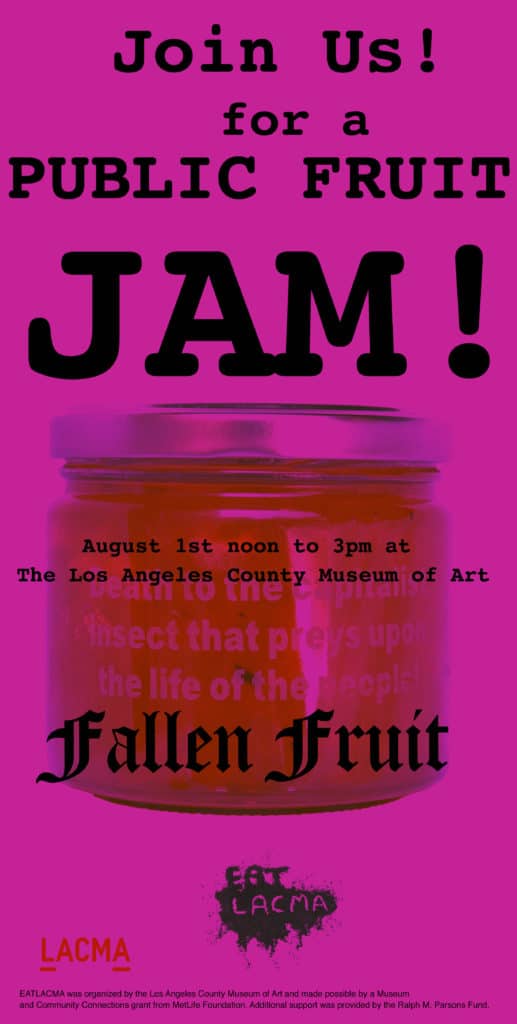
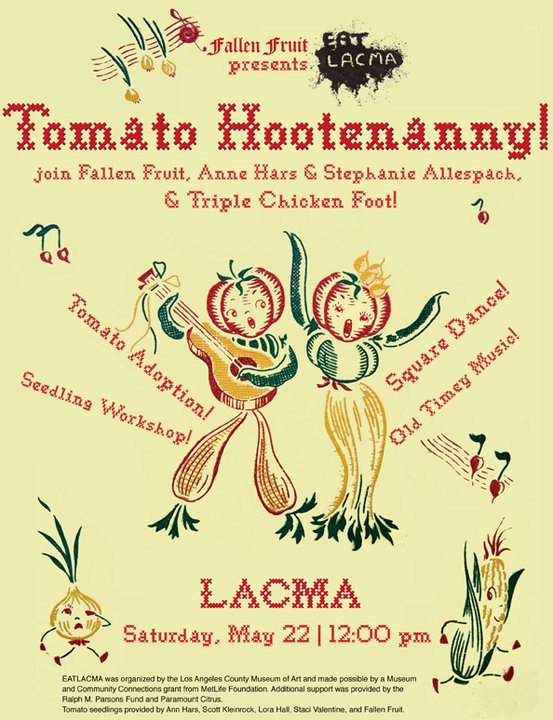
Among the artist’s projects to be seen or experienced are a tomato fight; a song and story cycle on the mystery of the knife, fork and spoon; an electronic melon drumming circle; a watermelon eating contest; Salome seducing her lover through the language of food; and a large Mandala of dinner plates ritually assembled and then dismantled by visitors who take home each plate. Other projects include a Prison Gourmet selection of food served to prisoners in California jails, chewing carolers, and belly listening sessions in which we hear digestion at its pinnacle. Pulitzer- prize winning writer Jonathan Gold will read a text on Spam, inspired by the Ed Ruscha painting in LACMA’s collection, Actual Size, which depicts a flying can of Spam. Topping it off will be three Los Angeles muses (Karen Black, Ronee Blakley, and Phranc) singing for their suppers.
Also on view at Let Them Eat LACMA will be Public Fruit Theater, a garden created by Fallen Fruit, which features a theater in the round constructed
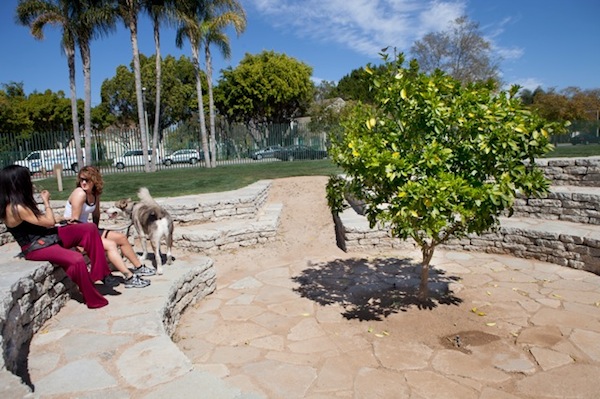
of reclaimed concrete sidewalks curving around a single citrus tree. The ―theater‖ is the durational performance of the fruit tree in its seasonal cycles, as well as viewers watching each other watch the tree grow. Public Fruit Theater comments upon LACMA’s neighborhood history as a one-time site of extensive citrus groves, as well as a meditation on today’s prevalence of concrete and lack of publically accessible or shared fruit trees.
Artists and collectives participating in Let Them Eat LACMA include Mark Allen, Gina Badger, Karen Black, Ronee Blakley, Lauren Bon, Michelle Carr, Robert Crouch, Cloud Eye Control, DidierHess, Harry Dodge, Jeanne Dunning, Fallen Fruit, Finishing School, Liz Glynn, Jonathan Gold, Veronica Gonzalez, Sean Griffin, Dana Gringas, Liz Hansen, Micol Hebron, Anna Homler, The Infamous Boom Boom!, Dawn Kasper, Emily Katrencik, Killsonic, John Knuth, Kadet Kuhne, Ann Magnuson, My Barbarian, National Bitter Melon Council, Gina Osterloh, Adam Overton, Sun-Yun Park, Phranc, Miss Barbie- Q., Marco Rios, Roots of Compromise, Jennifer Rubell, Susan Simpson, Slanguage, Åsa Sonjasddotter, Squeaky Blonde, Kim Stringfellow, Lisa Teasley, Stephen van Dyck, We Are The World, Michiko Yao, and Bari Ziperstein.
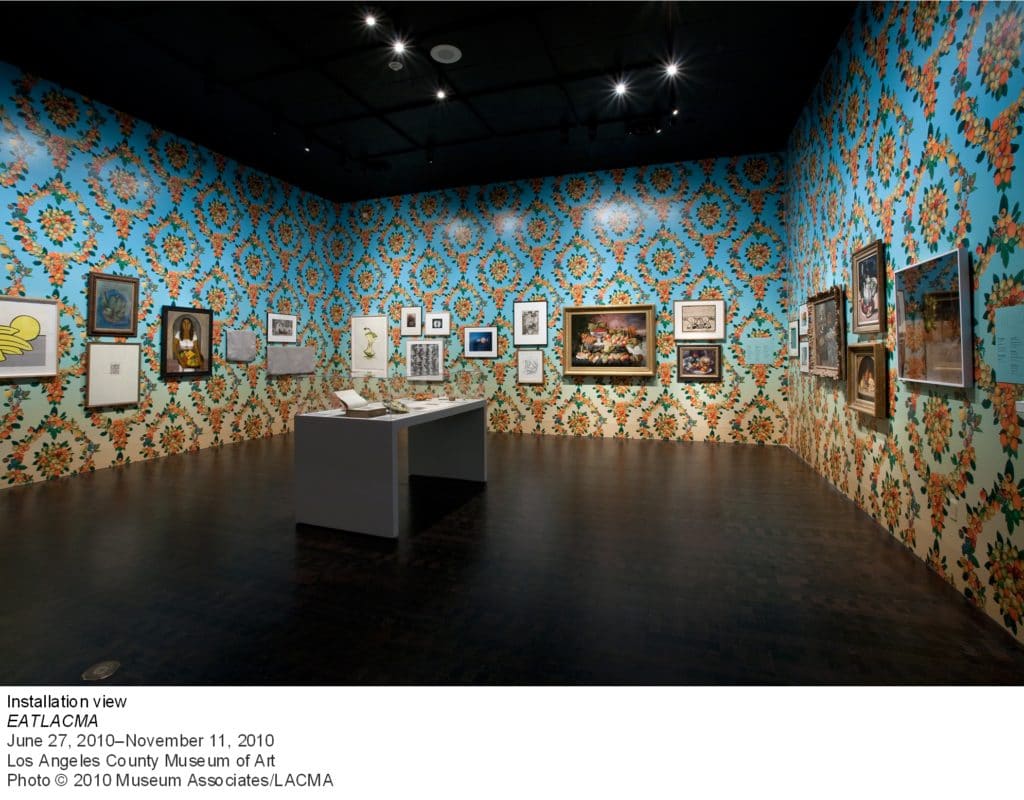
EATLACMA
EATLACMA plays the richness of the museum’s permanent collection against the natural growth cycle of gardens to create a year of programming in three acts. EATLACMA has unfolded seasonally to include The Gardens of LACMA, a curated set of gardens on the museum’s campus; The Fruit of LACMA, an exhibition curated by Fallen Fruit that draws from LACMA’s collection; and Let Them Eat LACMA.
The Fruit of LACMA assembles works from the museum’s permanent collection in several forms of media, including painting, photography, and decorative arts. The exhibition also features new work by Fallen Fruit, including Fruit Machine, a series of video portraits of people eating fruit, and Public Fruit Wallpaper, a decorative wallpaper pattern assembled from fruit publicly available and found in Silver Lake, Los Angeles, over the course of one day. The Gardens of LACMA showcases artist-designed gardens
installed throughout the LACMA grounds. Each artist’s garden examines public space, the actualities and symbols of food, and the people who give these things meaning.
EATLACMA is curated by Fallen Fruit—David Burns, Matias Viegener, and Austin Young—and José Luis Blondet, LACMA’s associate curator of special initiatives. For information online, visit eatlacma.org, and to view or contribute photos of events, gardens at the museum, fruit trees that have been planted, and all things EATLACMA, visit flickr.com/groups/eatlacma
Gardens of LACMA: Where You Can Have Your Art and Eat It Too! – Huffington Post
A Public Monument to the Fruit Tree – Lacma Unframed
Fallen Fruit Presents Let Them Eat LACMA –
Fruta Urbana, Tijuana
Accion Fruta Urbana / Urban Fruit Action Tijuana, outdoor public installation, 2010
Our Urban Fruit Actions differ from Fruit Tree Adoptions in being more hands-on. They are direct, cooperative plantings of fruit trees in an urban neighborhood. An ongoing project, they were first initiated in Tijuana, Mexico and Madrid, Spain. Each Urban Fruit Action is site-specific, designed to address the neighborhood that it occupies, and intended to transform the function of the place. Tijuana’s trees are located in 55-gallon barrels to facilitate their mobility in the rapidly transforming border neighborhood of Colonia Federal. The barrels were designed by Peruvian artist Giacomo Castagnola with the colors of the Mexican and United State’s flags.

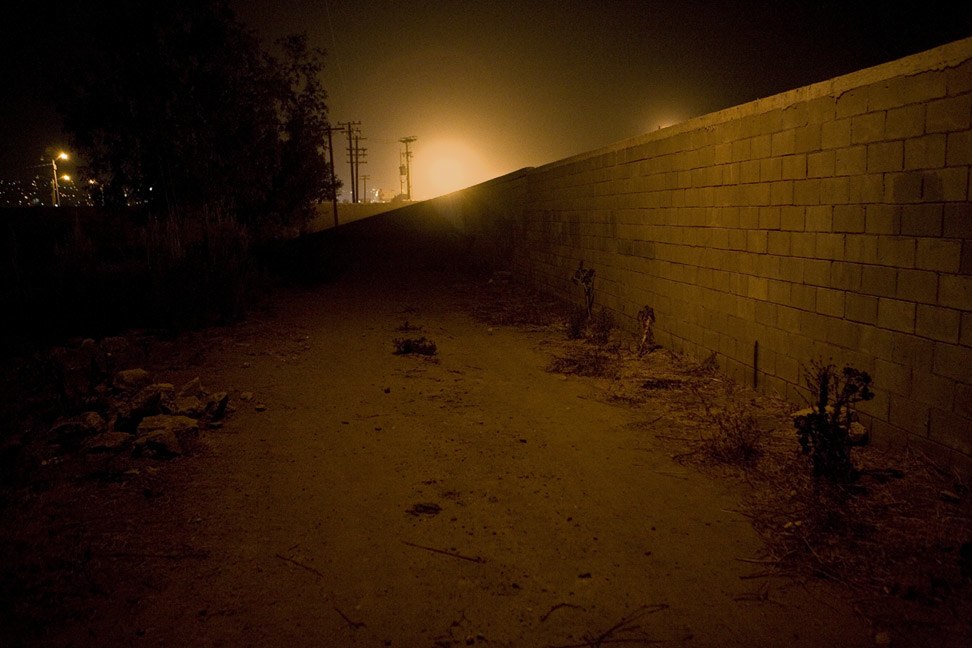
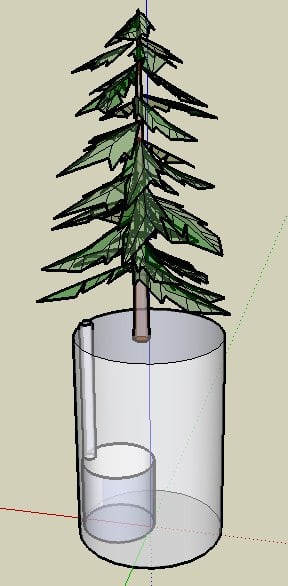

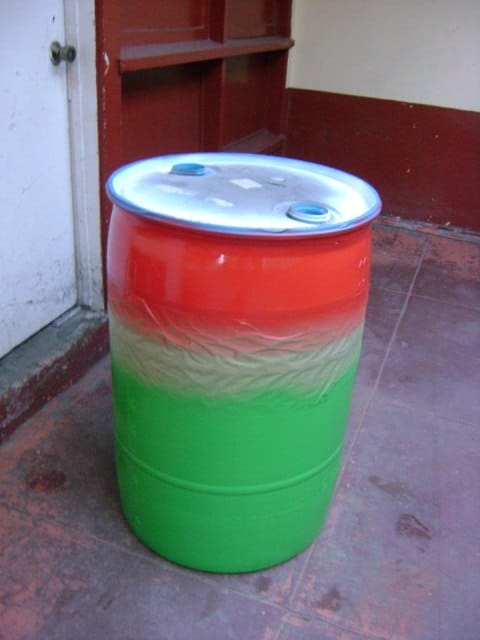
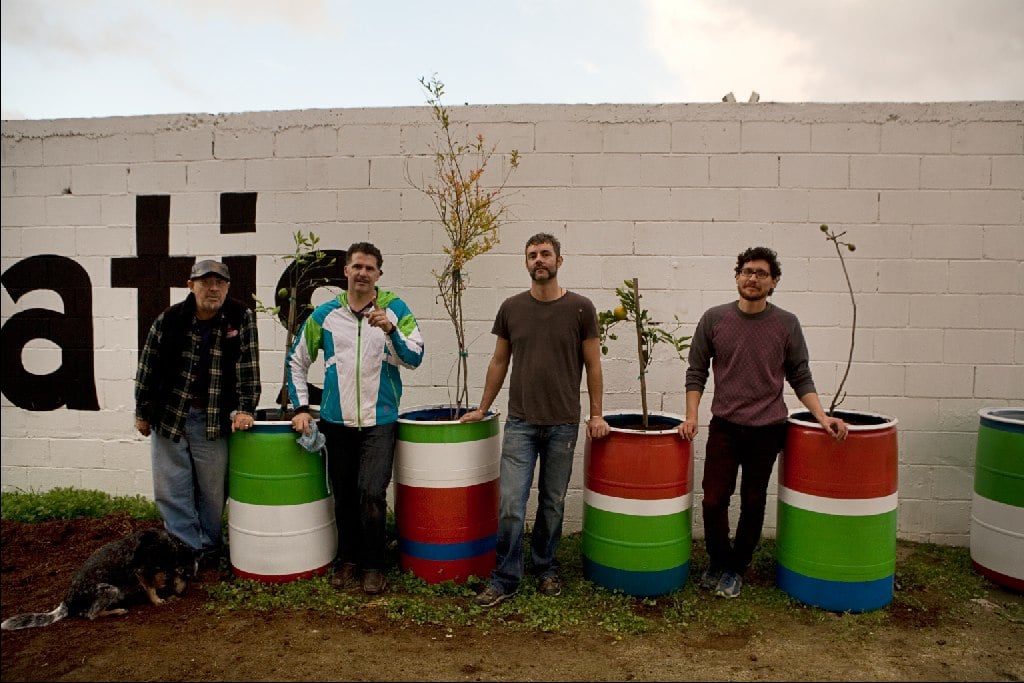
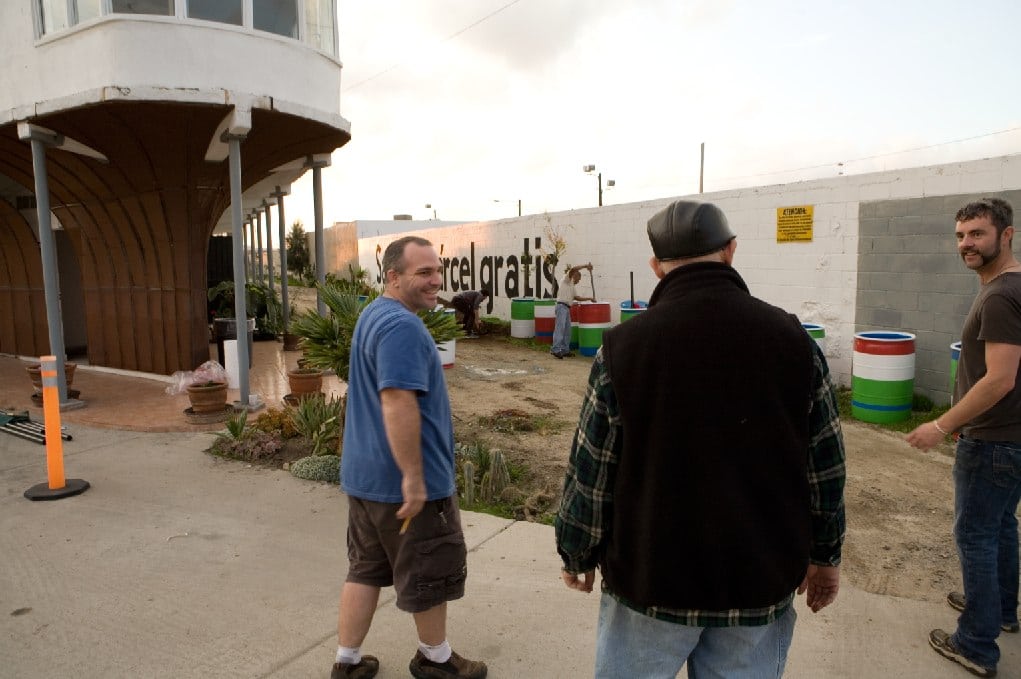
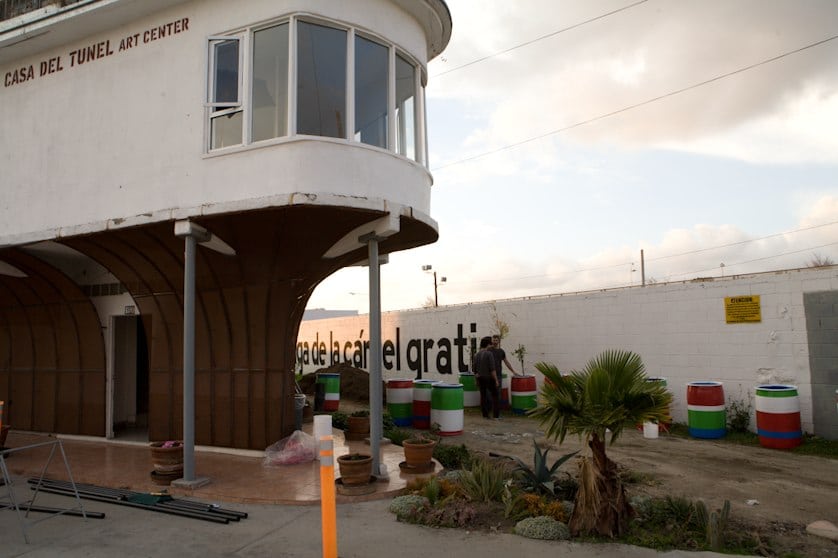
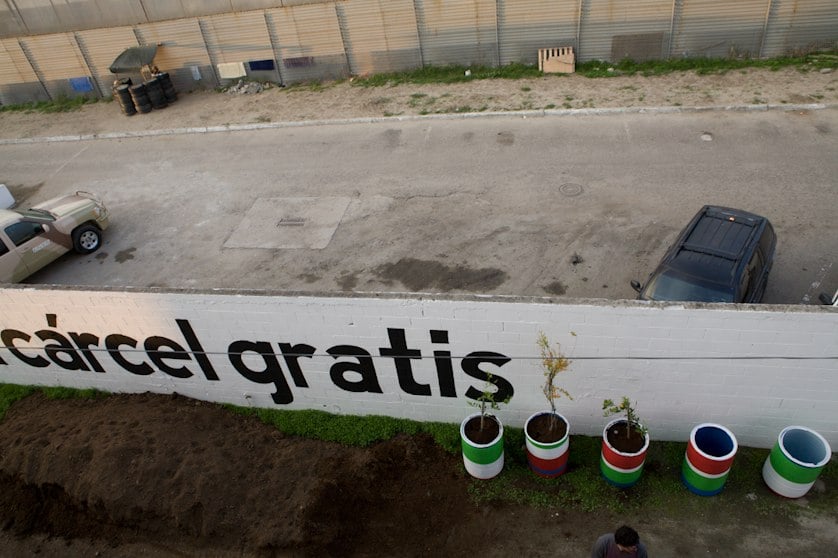
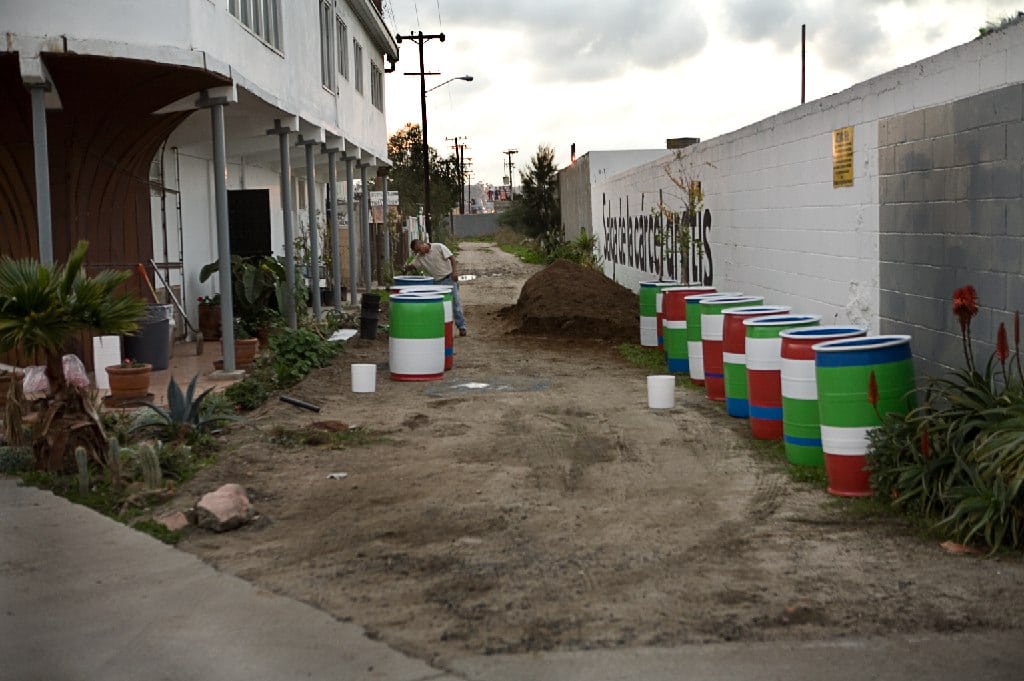




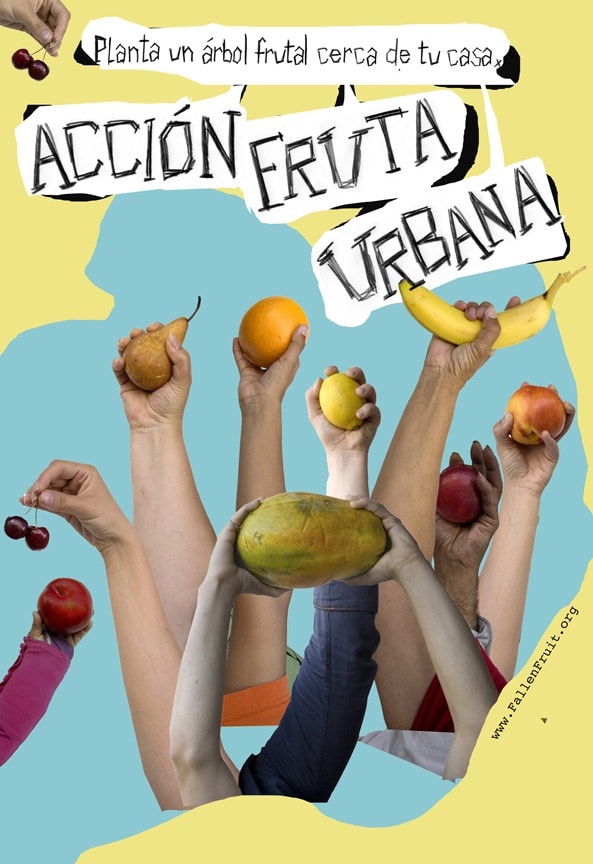

Fruta Urbana, Madrid
Accion Fruta Urbana / Urban Fruit Action Madrid, outdoor public installation, 2010
Our Urban Fruit Actions differ from Fruit Tree Adoptions in being more hands-on. They are direct, cooperative plantings of fruit trees in an urban neighborhood. An ongoing project, they were first initiated in Tijuana, Mexico and Madrid, Spain. Each Urban Fruit Action is site-specific, designed to address the neighborhood that it occupies, and intended to transform the function of the place. The trees in Madrid were originally intended to be dispersed in public space in the neighborhood around the Matadero arts complex, but their planting was stopped by the city. The trees found a home in Esta es una plaza, a communal garden in the neighborhood of Arganzuela: there they transform a former urban wasteland into a shared, multivalent space.
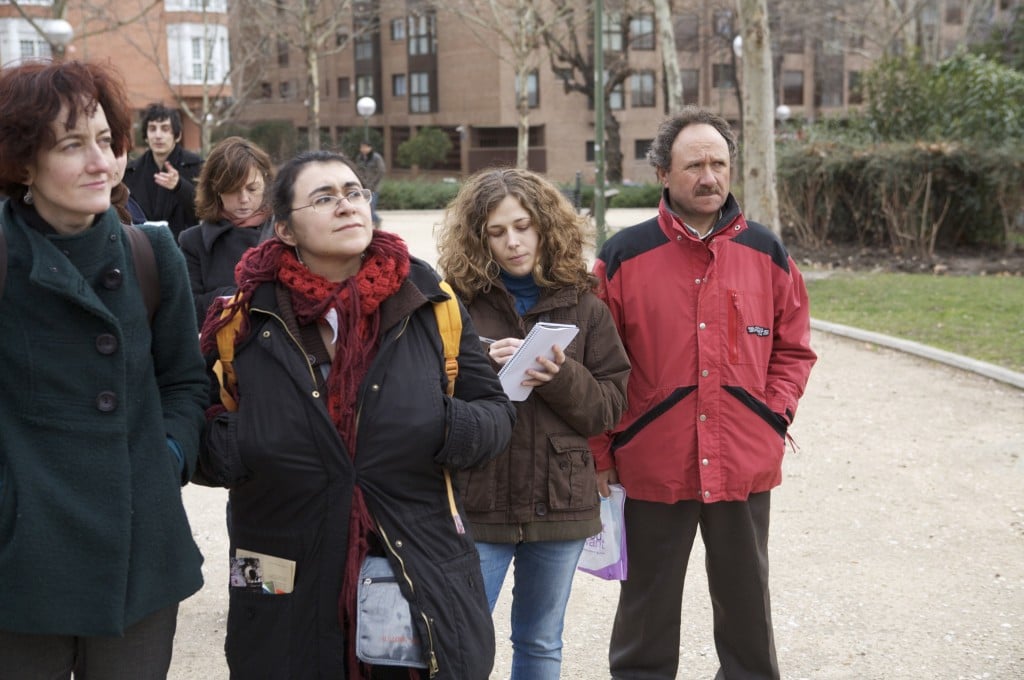
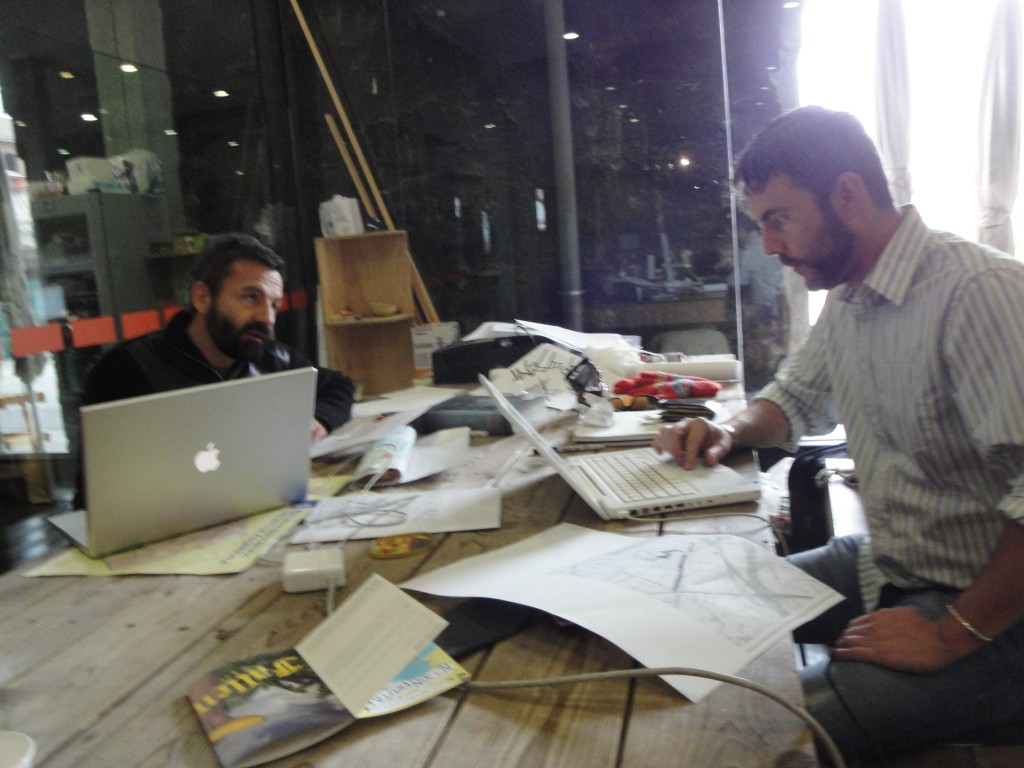
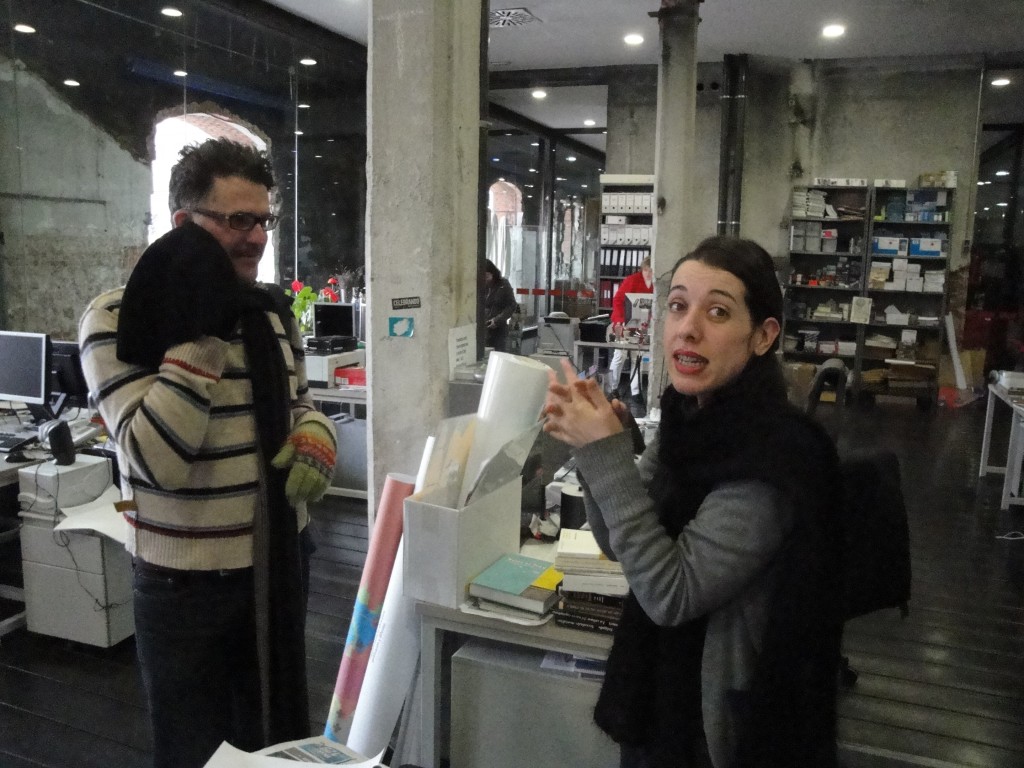
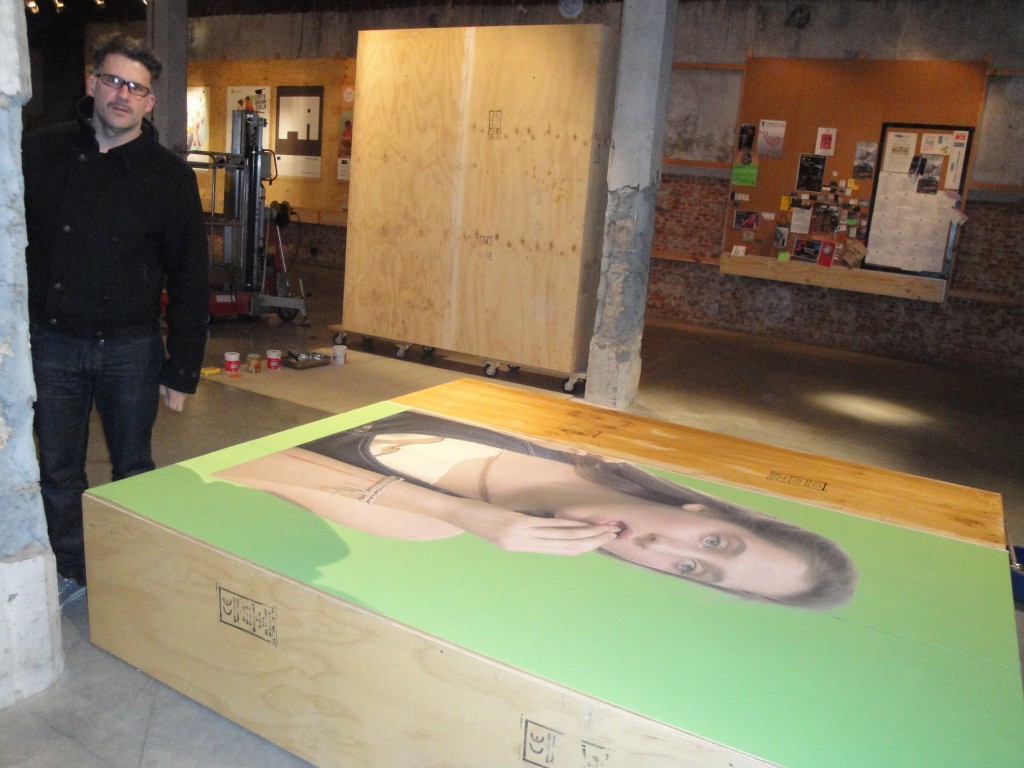



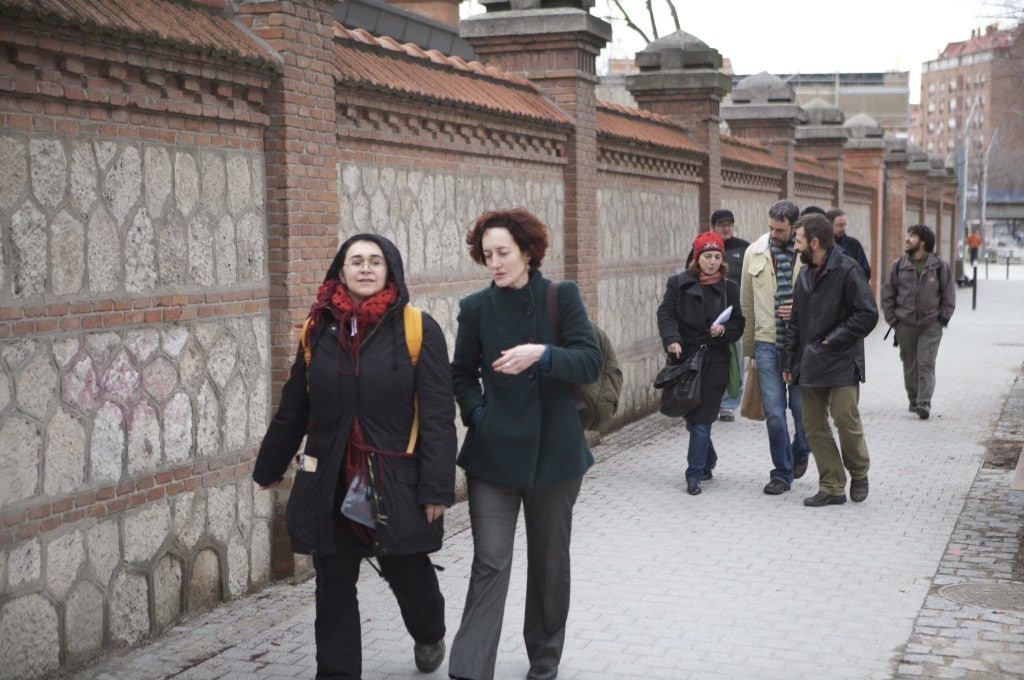
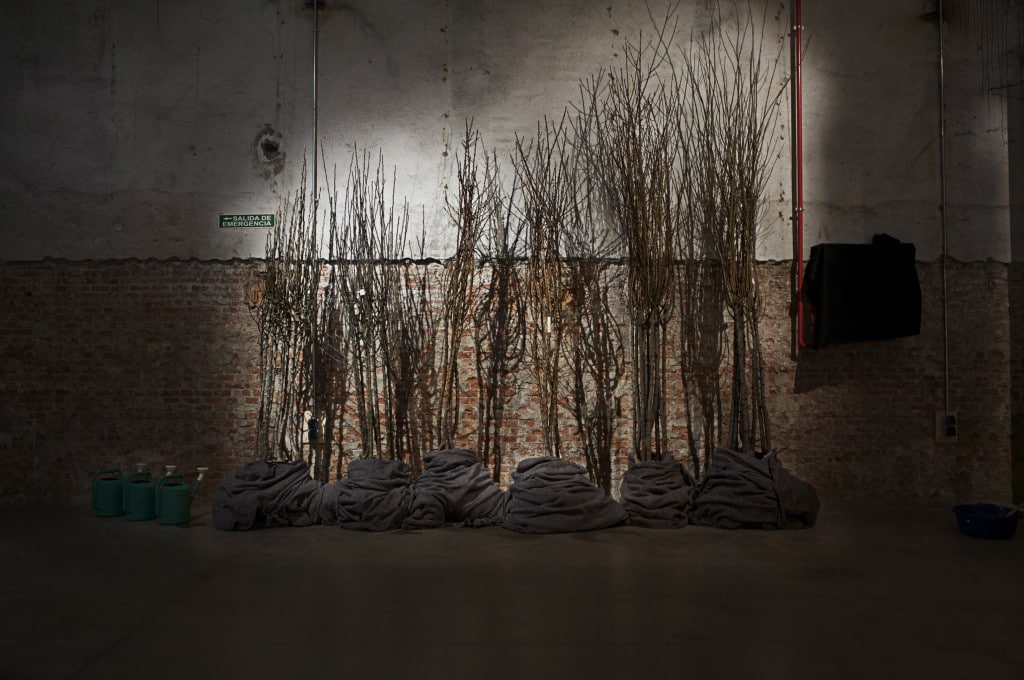
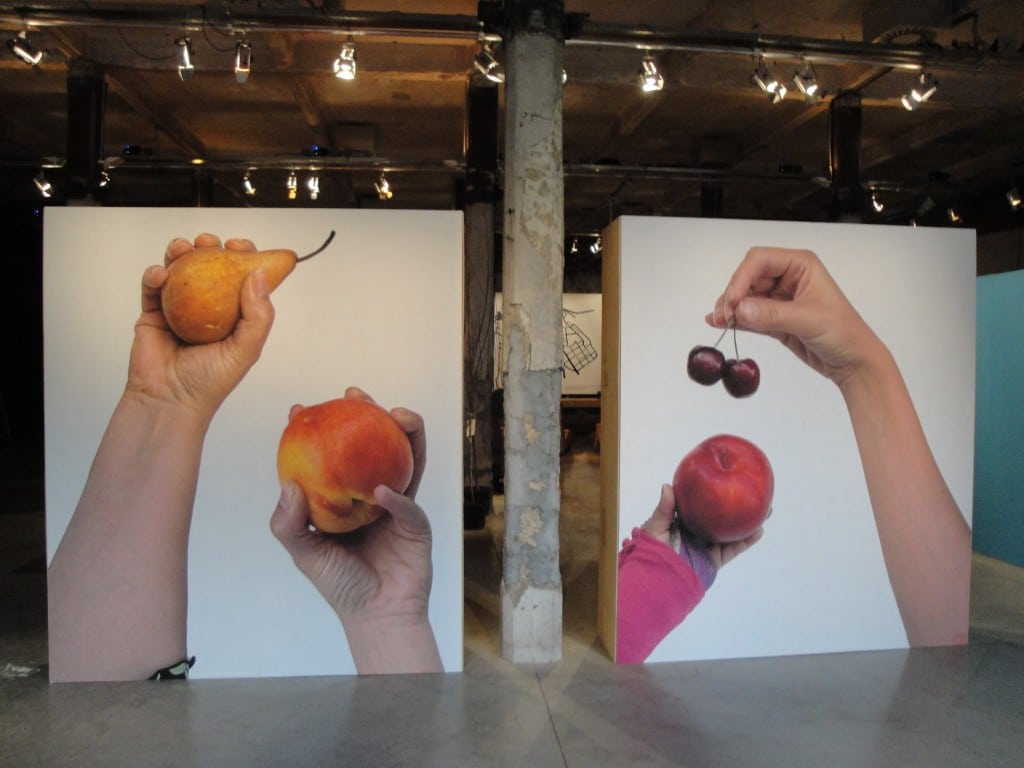
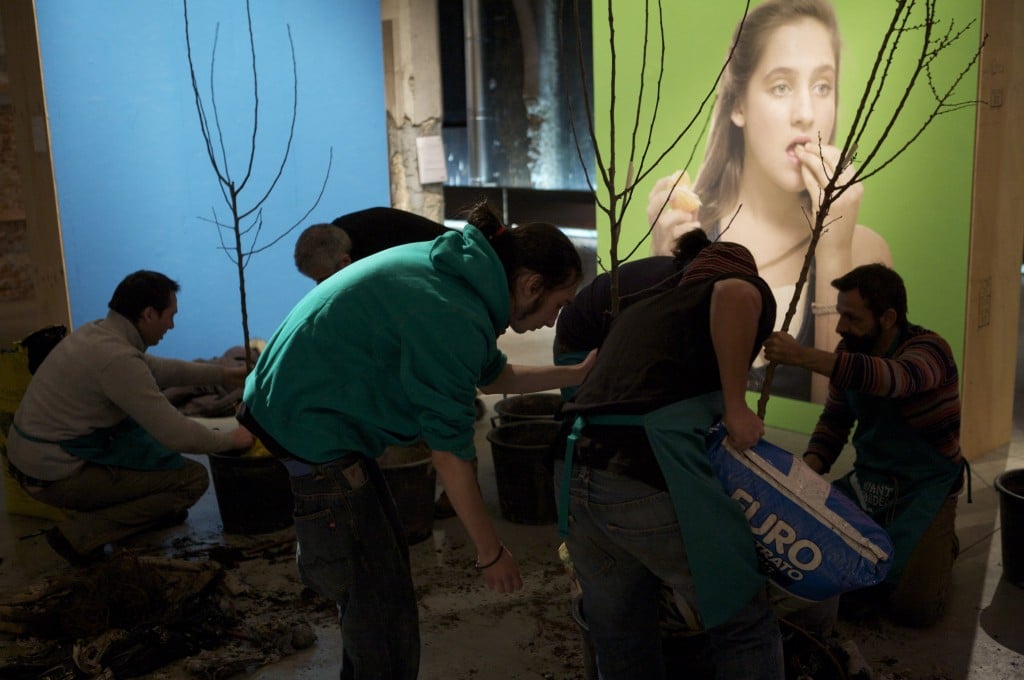
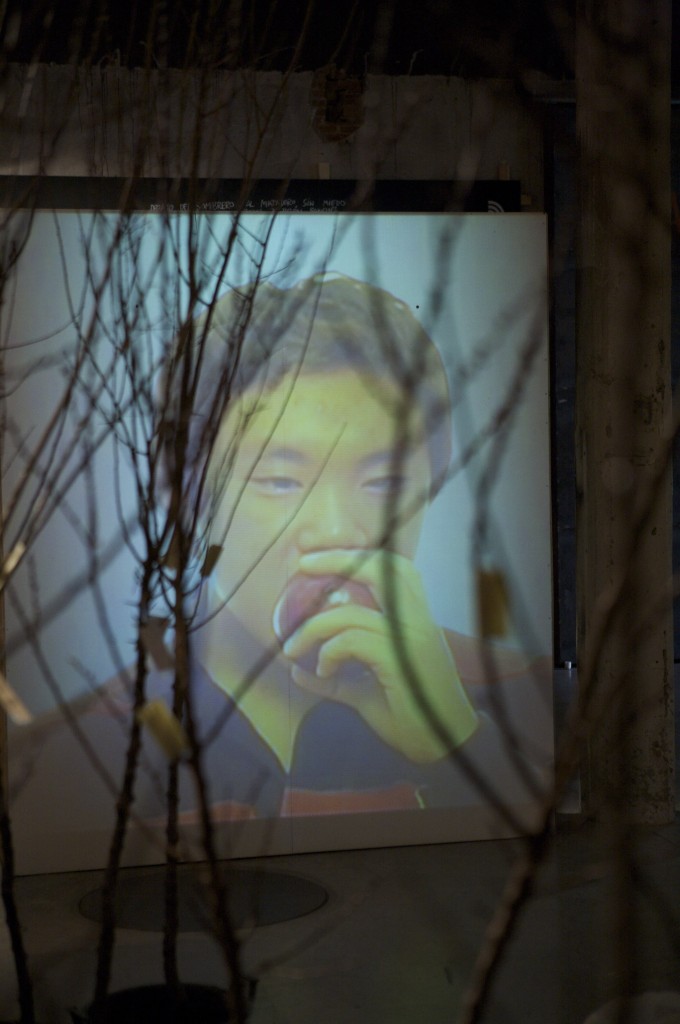
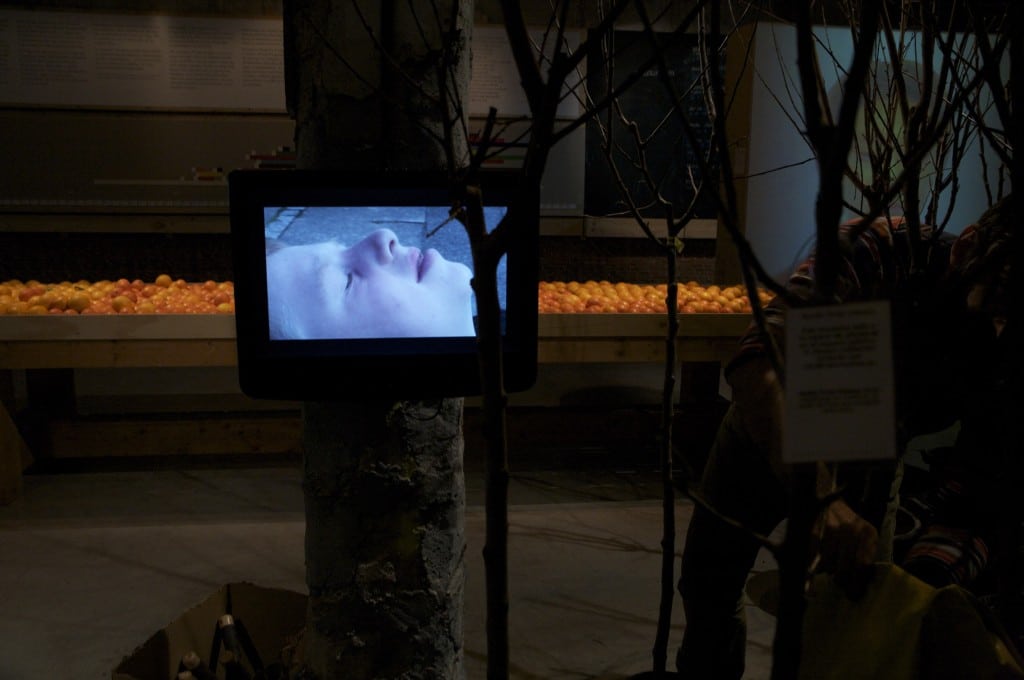
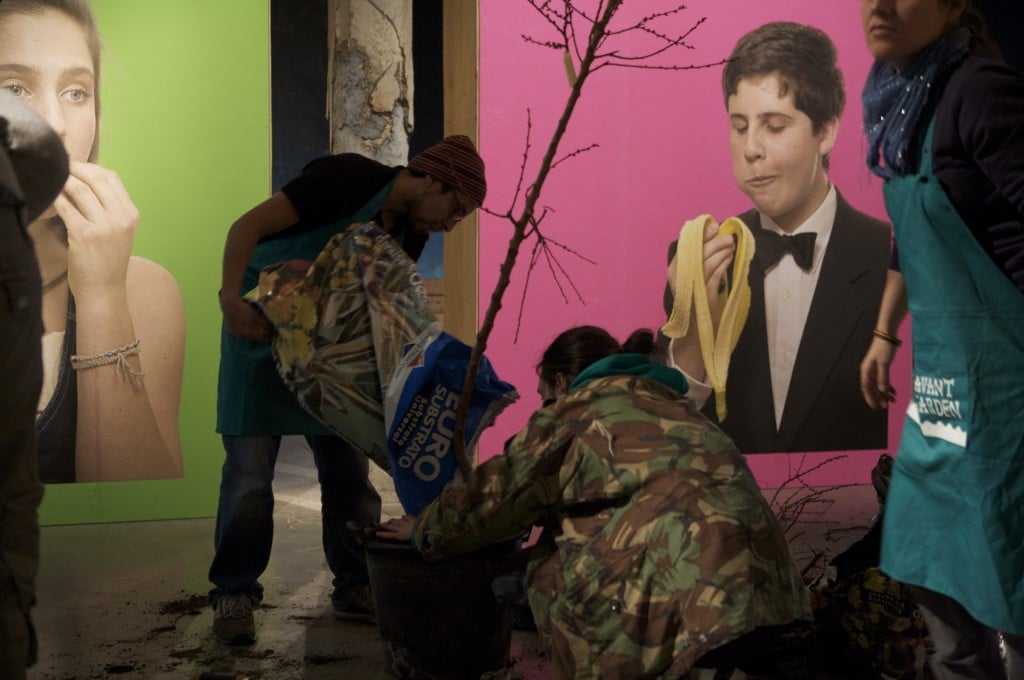
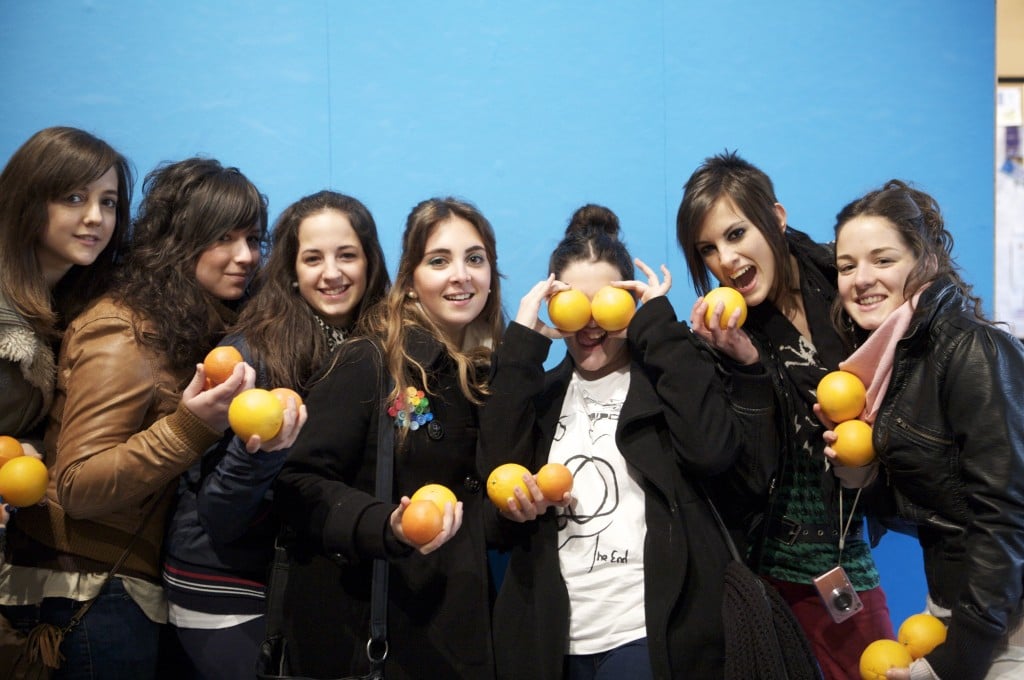
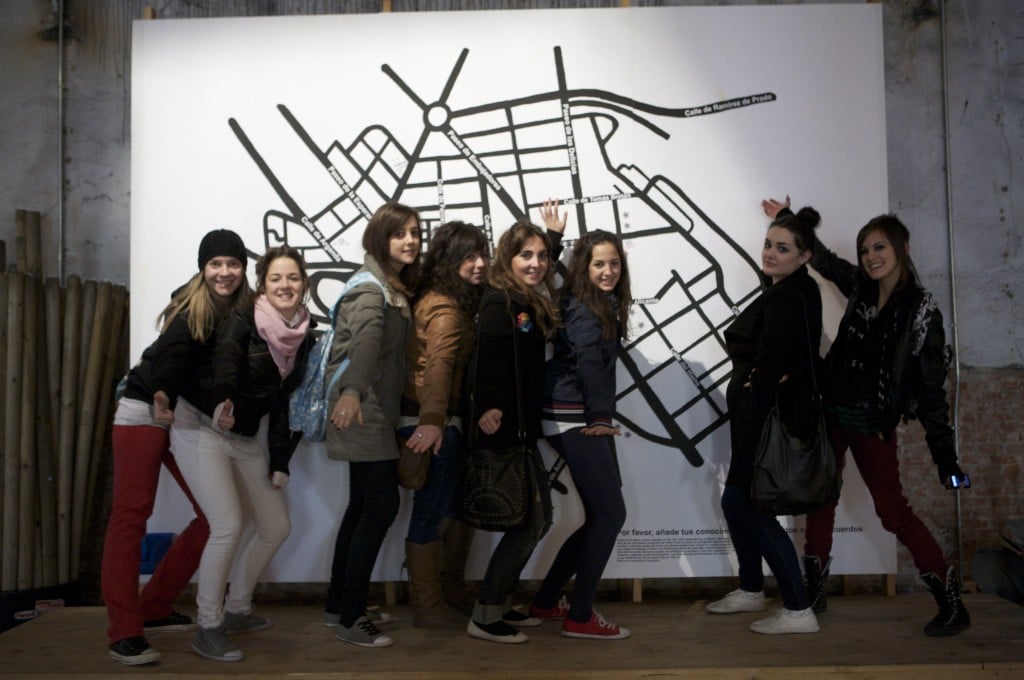
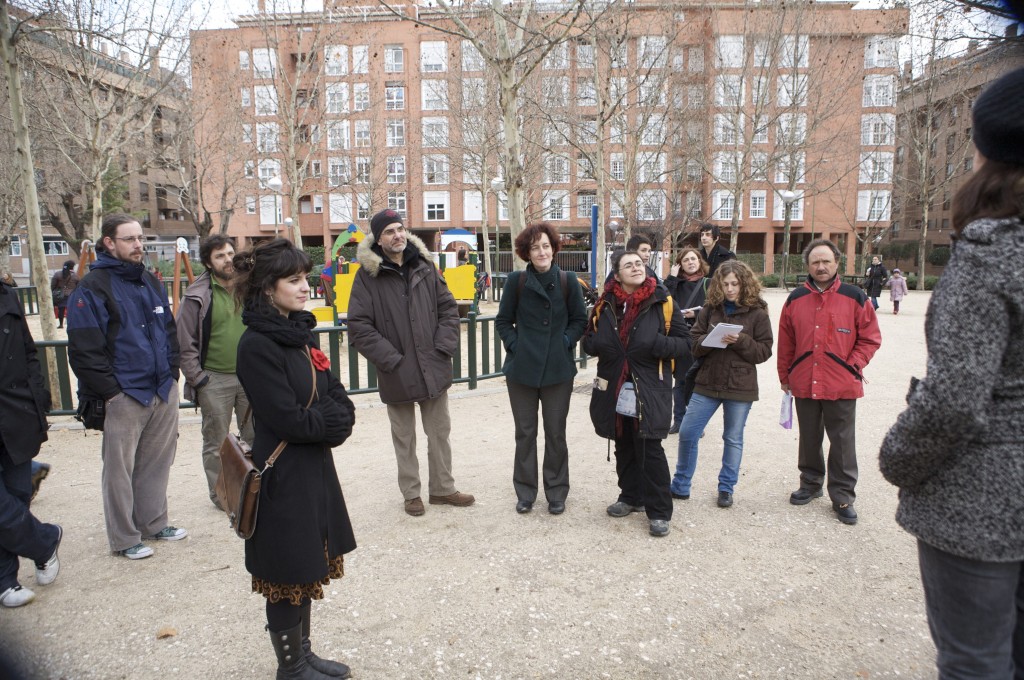
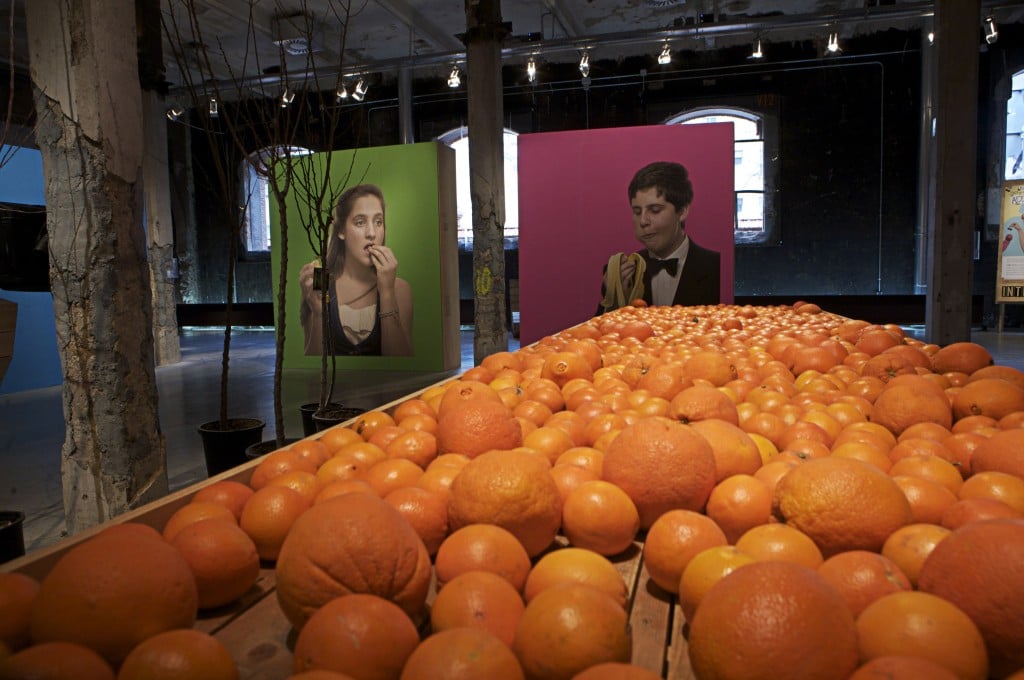
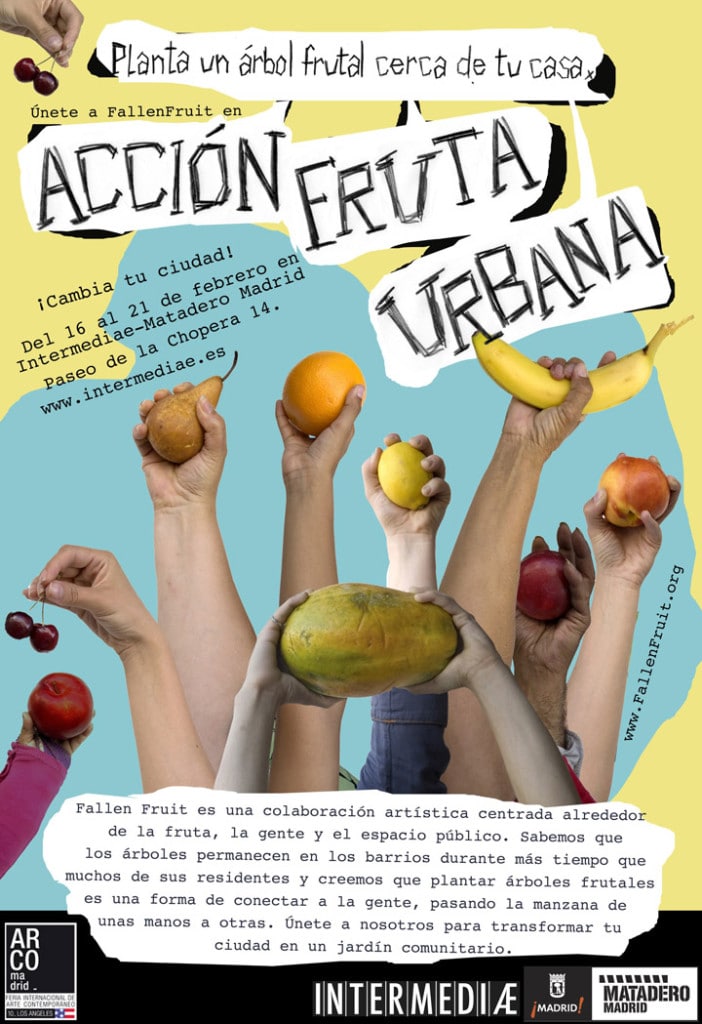
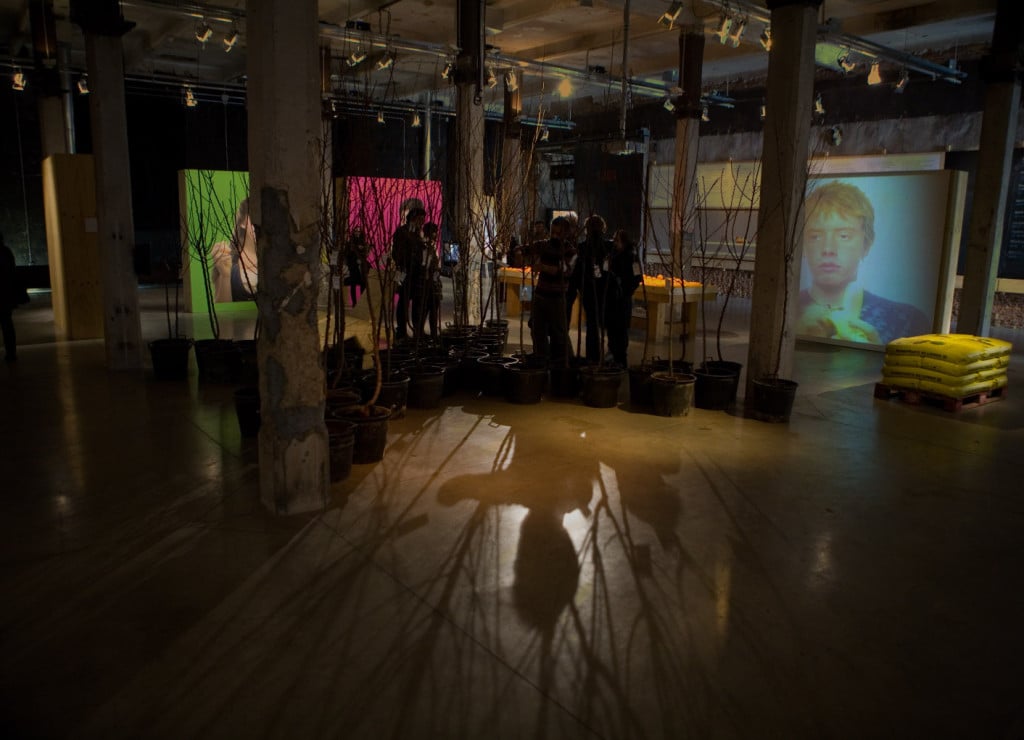
Double Standard
Using unedited documentary footage of a Neighborhood Fruit Forage, this video takes the viewer in real time through a tour of Fallen Fruit’s home neighborhood in Los Angeles. The two channels (from the perspective of the two cameras) are overlaid with a text block of comments from a short public television video of the same event, posted on YouTube. The comments create an alternative, cynical narrative to the events, with crude, homophobic and racist comments mixed in with a few acute observations. A play between action and commentary, Double Standard challenges the authenticity of the participant’s or viewer’s experience. The slippery space between these two narratives probes at the correspondence between the public walking on the tour and the anonymous public of the internet.

Double Standard, High Definition video, 30min TRT, video still, 2008















